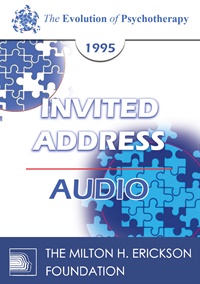
- Average Rating:
- Not yet rated
- Topic Areas:
- Invited Addresses | Focusing | Mind-Body | Psychotherapy
- Categories:
- Evolution of Psychotherapy | Evolution of Psychotherapy 1995
- Faculty:
- Eugene Gendlin, PhD | James Hillman, PhD
- Duration:
- 1 Hour 27 Minutes
- Format:
- Audio Only
- Original Program Date:
- Dec 16, 1995
- Short Description:
- Focusing is bodily attention, not to mere sensations but to an at first unclear, implicitly complex bodily sense-of a situation, problem, or aspect of life. Therapy deepens immediately with many clients if asked what physical sense comes in the middle of the body in relation to what is being worked on. With half a minute of repeated direct attention, clients can assign a "quality-word," e.g., "heavy," "fluttery," or "tight." Then small steps come to say the crux of the problem. Each brings a slight (later large) "shift" and release, a direct sense of validity, although further steps may again change the whole problem.
- Price:
- $15.00 - Base Price
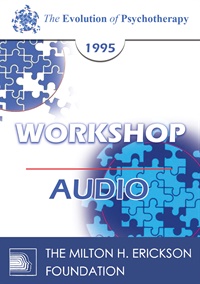
- Average Rating:
- Not yet rated
- Topic Areas:
- Workshops | Bioenergetics | Mind-Body | Psychotherapy
- Categories:
- Evolution of Psychotherapy | Evolution of Psychotherapy 1995
- Faculty:
- Alexander Lowen, MD | Heiner Steckel, Dipl. Pad.
- Duration:
- 2 Hours 30 Minutes
- Format:
- Audio Only
- Original Program Date:
- Dec 14, 1995
- Short Description:
- Patients come to therapy because they have problems. These problems range from difficulties in working, in social and sexual relationships and in functioning. Symptoms may be depression, anxiety and fear, or a general sense that life has no meaning. In all cases it can be seen that the body is emotionally crippled by chronic muscular tensions which limit the person's energy and decreases his vitality. In this workshop Lowen explains how one recognizes these tensions and how they can be released.
- Price:
- $15.00 - Base Price

- Average Rating:
- Not yet rated
- Topic Areas:
- Clinical Demonstrations | Mind-Body | Neuroscience | Psychotherapy | Hypnotic Phenomena
- Bundle(s):
- Pioneers of Psychotherapy Bundle
- Categories:
- Pioneers of Psychotherapy | Erickson Congress | Erickson Congress 1992
- Faculty:
- Ernest Rossi, PhD
- Course Levels:
- Master Degree or Higher in Health-Related Field
- Duration:
- 01:01:00
- Format:
- Audio and Video
- Original Program Date:
- Dec 02, 1992
- Short Description:
- Rossi (1992) demonstrates his approach to mind-body healing while working with a volunteer, Jennifer, who has rheumatoid arthristis in her hands, which have become distorted and painful. Rossi explains that mind-body healing follows a predictable pattern. During the final phase of this approach, Jennifer begins to experience automatic movement in her hands. She exclaims that her hands are moving more freely than they have in the last five years. Rossi attributes the success to "a genuine moment of self-empowerment."
- Price:
- $59.00 - Base Price
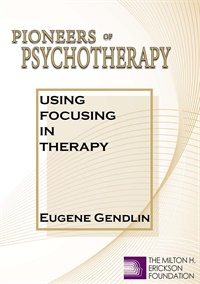
- Average Rating:
- Not yet rated
- Topic Areas:
- Clinical Demonstrations | Trauma | Psychotherapy | Focusing | Mind-Body
- Bundle(s):
- Pioneers of Psychotherapy Bundle
- Categories:
- Pioneers of Psychotherapy | Evolution of Psychotherapy | Evolution of Psychotherapy 2000
- Faculty:
- Eugene Gendlin, PhD
- Course Levels:
- Master Degree or Higher in Health-Related Field
- Duration:
- 00:54:00
- Format:
- Audio and Video
- Original Program Date:
- May 27, 2000
- Short Description:
- Eugene Gendlin (2000) demonstrates with two volunteers. The first is guided through feelings of tension in her shoulders and shakiness in her stomach. Gendlin conducts a second demonstration. The next volunteer presents the trauma of a hysterectomy due to cancer. Gendlin concludes with an explanation of his method.
- Price:
- $59.00 - Base Price
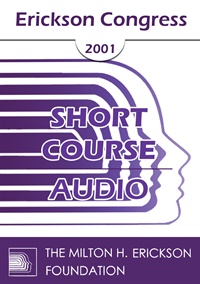
- Average Rating:
- Not yet rated
- Topic Areas:
- Short Courses | Mind-Body
- Categories:
- Erickson Congress 2001 | Erickson Congress
- Faculty:
- Bruce Gregory, PhD
- Duration:
- 1:18:24
- Format:
- Audio Only
- Original Program Date:
- Dec 06, 2001
- Short Description:
- IC01 Short Course 12 - The Relationship and Relevance of Dr. Rossi's Mind-Body Work to Other Therapeutic Modalities - Bruce Gregory, PhD Over the past 20 years Dr. Rossi has innovatively expanded Ericksonian work by demonstrating its connections to microbiology, chemistry, physics, chaos theory and mathematics. This course will explore the relationship and relevance of Dr. Rossi's mind-body work to other forms of psychotherapy. We will learn how mind-body work utilizes and integrates many of the core processes used in the work of Winnecott, Klein, Jung, Gestalt, Masterson, Kohut and cognitive therapy.
- Price:
- $15.00 - Base Price
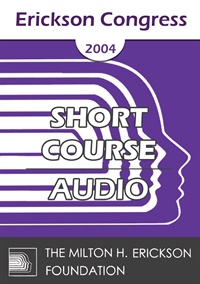
- Average Rating:
- Not yet rated
- Topic Areas:
- Short Courses | Mind-Body | Trauma | Brief Therapy | Ericksonian Hypnosis and Therapy Techniques | Trance | Hypnotic Induction | Pain and Healing | Hypnosis
- Categories:
- Erickson Congress | Erickson Congress 2004
- Faculty:
- Ronald Alexander, PhD | Anita Jung, M.S.
- Duration:
- 1:19:45
- Format:
- Audio Only
- Original Program Date:
- Dec 02, 2004
- Short Description:
- This workshop will address the rapid treatment of trauma and psychosomatic disorders by utilizing an Ericksonian orientation that understands the importance of the symptom as a pathway to inner healing. The skills needed for the rapid treatment of trauma will be reviewed. The course will highlight Ericksonian methods for the immediate reorganization of transforming somatic-affective experience into new healing rhythms in the body.
- Price:
- $15.00 - Base Price
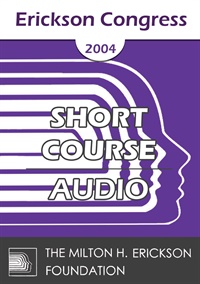
- Average Rating:
- Not yet rated
- Topic Areas:
- Short Courses | Mind-Body | Cognitive Behavior Therapy (CBT) | Ericksonian Hypnosis and Therapy Techniques | Psychotherapy
- Categories:
- Erickson Congress | Erickson Congress 2004
- Faculty:
- Bruce Gregory, PhD
- Duration:
- 1:19:45
- Format:
- Audio Only
- Original Program Date:
- Dec 02, 2004
- Short Description:
- Over the past 20 years Dr. Rossi has innovatively expanded Ericksonian work by demonstrating its connections to microbiology, chemistry, physics, chaos theory and mathematics. This course will explore the relationship and relevance of Dr. Rossi's mind- body work to other forms of psychotherapy. We will learn how mind-body work utilizes and integrates many of the core processes used in the work of Winnecott, Klein, Jung, Gestalt, Masterson, Kohut and cognitive-behavioral therapy.
- Price:
- $15.00 - Base Price
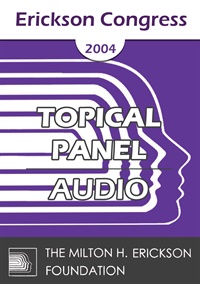
- Average Rating:
- Not yet rated
- Topic Areas:
- Topical Panels | Hypnosis | Mind-Body
- Categories:
- Erickson Congress | Erickson Congress 2004
- Faculty:
- Sidney Rosen, MD | Carol Kershaw, EdD | Ernest Rossi, PhD | Bernhard Trenkle, Dipl. Psych
- Duration:
- 59:28
- Format:
- Audio Only
- Original Program Date:
- Dec 03, 2004
- Short Description:
- IC04 Topical Panel 07 - Mind/Body/Medical Hypnosis - Carol Kershaw, Ed.D,. Sidney Rosen, M.D., Ernest Rossi, Ph.D., Bernhard Trenkle, Dipl. Psych.
- Price:
- $15.00 - Base Price
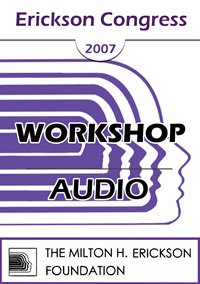
- Average Rating:
- Not yet rated
- Topic Areas:
- Workshops | Mind-Body | Neuroscience | Therapist Development | Psychotherapy
- Categories:
- Erickson Congress | Erickson Congress 2007
- Faculty:
- Ernest Rossi, PhD | Kathryn Rossi, PhD
- Duration:
- 1:54:32
- Format:
- Audio Only
- Original Program Date:
- Dec 06, 2007
- Short Description:
- Let’s rework and reframe natural life transitions as positive. Disease models have no place in natural processes. Explore these aspects of change on the deepest levels of gene expression and brain plasticity during mind-body communication and healing in psychotherapy. Let’s explore how we can optimize our lives in an age of unprecedented scientific advances.
- Price:
- $15.00 - Base Price

- Average Rating:
- Not yet rated
- Topic Areas:
- Short Courses | Belief Systems | Mind-Body | Multicultural | Psychotherapy
- Categories:
- Erickson Congress | Erickson Congress 2007
- Faculty:
- Jeanne Hernandez
- Duration:
- 1:19:28
- Format:
- Audio Only
- Original Program Date:
- Dec 07, 2007
- Short Description:
- This workshop explores how the Native American belief system contains ingredients to keep the mind and body in harmony and promote well-being. We will explore adding time-frames, respect and gratitude; the circle of life, and symbols as reminders of the "right" path.
- Price:
- $15.00 - Base Price
Please wait ...

